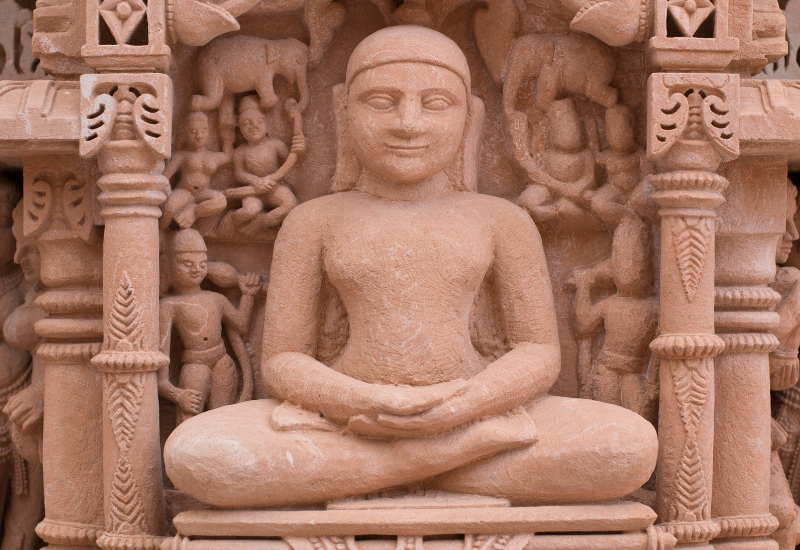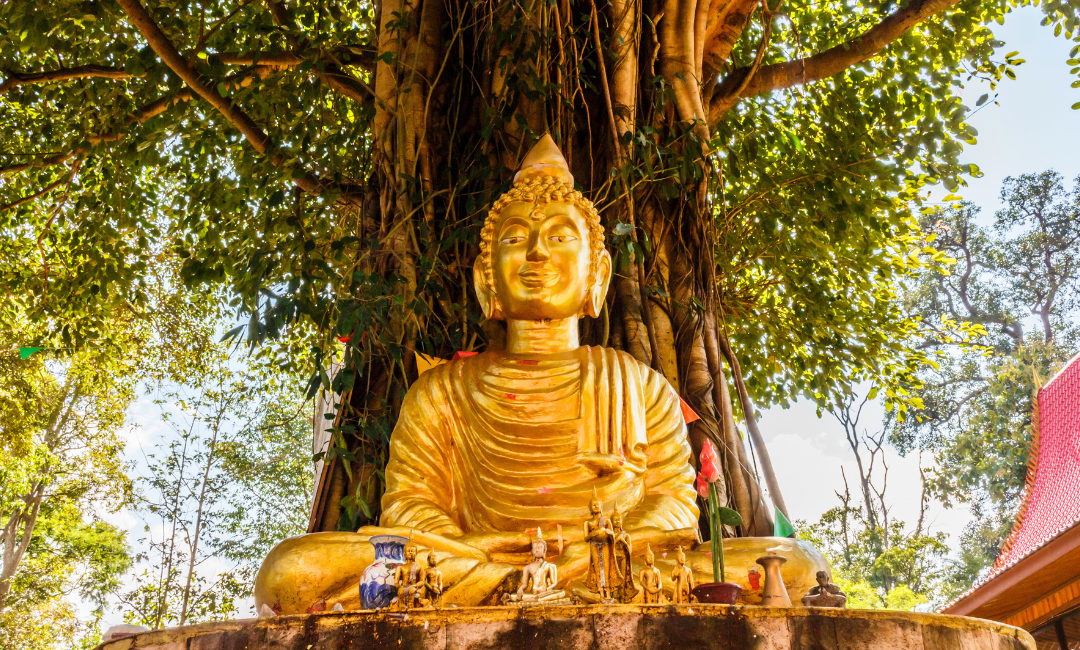Moksha is a profound concept in Indian philosophical traditions, often defined as liberation, salvation, or release from the cycle of birth, death, and rebirth (samsara). It represents the ultimate goal of human existence, intertwined with notions of enlightenment, self-realization, and union with the divine. Although the concept is widely recognized across Hinduism, Buddhism, and Jainism, its interpretations and implications can vary significantly. What is Moksha? What does it mean in the context of the three religions, and what is believed to happen after achieving Moksha according to each of them?
What is Moksha According to Hinduism?
In Hinduism, moksha is the ultimate goal of life and represents the liberation of the soul (atman) from the cycle of samsara. This cycle is characterized by a continuous sequence of birth, death, and rebirth, wherein the soul undergoes various experiences based on its past karma (actions). The concept of moksha is deeply rooted in the Vedas, Upanishads, and various philosophical schools, each offering a unique perspective.
The Role of Dharma and Karma in Achieving Moksha
Achieving moksha is not simply about escaping the cycle of samsara; it necessitates understanding and fulfilling one’s dharma—the moral and ethical duties one has in life. Each person’s dharma is influenced by factors such as age, caste, gender, and personal circumstances. Fulfilling one’s dharma is seen as a means of purifying the soul, contributing to the greater good, and ultimately paving the way toward liberation.
Additionally, the concept of karma plays a crucial role in this journey. Every action, whether good or bad, has consequences that determine the circumstances of future lives. Thus, the accumulation of positive karma through righteous living contributes to progressing toward moksha. The path to liberation is often portrayed as a balance of action (karma) and non-attachment to outcomes, as seen in the teachings of the Bhagavad Gita. In this scripture, Lord Krishna advises that one must act according to dharma without concern for success or failure, thus transcending the dualities of life.
The Four Goals of Life
In Hinduism, life is traditionally divided into four primary goals, known as the Purusharthas: dharma (righteousness), artha (prosperity), kama (pleasure), and moksha (liberation). The pursuit of these goals is seen as a holistic approach to living a fulfilling life. While dharma, artha, and kama are essential for a balanced existence, moksha is considered the ultimate fulfillment.
Many scriptures emphasize that while one can enjoy the worldly pleasures and responsibilities of life, they should ultimately strive for moksha, as it transcends the transient pleasures of the material world. This pursuit encourages individuals to rise above mundane attachments and aspirations, focusing on the eternal essence of the soul.
The Influence of Bhakti and Mysticism
In addition to the philosophical paths outlined in the scriptures, the Bhakti movement has significantly influenced the understanding of moksha in Hinduism. This devotional movement emphasizes a personal relationship with the divine through love and worship. Bhakti saints, such as Meera Bai and Tulsidas, advocated that devotion to God could lead to liberation.
This path of devotion is often seen as a direct and accessible route to moksha, emphasizing emotional connection and surrender over rigorous philosophical inquiry or ascetic practices. This approach democratizes the spiritual journey, allowing individuals from all walks of life to aspire for liberation through love, humility, and unwavering faith.
Pathways to Moksha
Hinduism outlines multiple pathways to attain moksha, primarily categorized into four yogas:
Karma Yoga (The Path of Action):
This involves selfless action and fulfilling one’s duties without attachment to the fruits of the actions. By performing one’s dharma (righteous duties), individuals can purify their hearts and progress toward liberation.
Bhakti Yoga (The Path of Devotion):
This path emphasizes devotion to a personal deity, cultivating love and surrender to God. Through intense devotion, one can transcend the ego and realize their oneness with the divine.
Jnana Yoga (The Path of Knowledge):
This pathway focuses on spiritual knowledge and wisdom. It involves deep inquiry into the nature of reality, leading to self-realization and understanding the unity of the individual soul with the universal soul (Brahman).
Dhyana Yoga (The Path of Meditation):
Meditation practices help individuals attain inner peace and realization of the self. Through concentration and mindfulness, one can experience the divine essence and attain moksha.
Philosophical Underpinnings
Different philosophical schools within Hinduism interpret moksha in distinct ways:
Advaita Vedanta posits that moksha is realized when one recognizes the non-duality of the atman and Brahman. The illusion (maya) of separateness vanishes, leading to the realization of the ultimate reality.
Dvaita Vedanta emphasizes the distinction between the individual soul and the Supreme Being, suggesting that moksha is attained through devotion to God.
Samkhya focuses on self-realization and understanding the distinction between purusha (consciousness) and prakriti (nature), advocating for liberation through knowledge and detachment.

What is Moksha According to Buddhism?
In Buddhism, the concept analogous to moksha is Nirvana. While it shares similarities with the Hindu understanding, it is fundamentally different in its teachings and implications. Buddhism does not emphasize a permanent soul (anatta), nor does it posit an eternal divine essence.
The Nature of Nirvana
Nirvana is described as the cessation of suffering, desire, and ignorance, marking the end of the cycle of birth, death, and rebirth (samsara). It is characterized as an ineffable state beyond all conceptualization, where one attains ultimate peace and liberation from the self-imposed constraints of existence.
The Path to Nirvana
Buddhism prescribes the Noble Eightfold Path as the way to achieve Nirvana, which consists of:
Right Understanding: Understanding the Four Noble Truths and the nature of reality.
Right Intent: Cultivating intentions of renunciation, goodwill, and non-harming.
Right Speech: Speaking truthfully and harmoniously, avoiding harmful words.
Right Action: Engaging in ethical conduct and refraining from harmful actions.
Right Livelihood: Earning a living in a way that does not harm others.
Right Effort: Cultivating wholesome states of mind while discarding unwholesome ones.
Right Mindfulness: Developing awareness of the body, feelings, mind, and phenomena.
Right Concentration: Practicing meditation to reach deeper states of awareness and realization.
Through the practice of this path, individuals progress toward enlightenment and ultimately the attainment of Nirvana.
What is Moksha According to Jainism?
Jainism presents another perspective on moksha, known as Kevala Jnana or the state of absolute knowledge. It is often viewed as the liberation of the soul from karmic bondage, achieved through strict adherence to ethical principles and ascetic practices.

Pathways in Jainism
For Jains, the path to moksha involves:
Right Faith (Samyak Darshana): Developing a deep conviction in the truth of the Jain teachings and the nature of reality.
Right Knowledge (Samyak Jnana): Gaining knowledge of the self, the universe, and the principles of karma.
Right Conduct (Samyak Charitra): Living a life of integrity, non-violence (ahimsa), truthfulness, and self-discipline.
These components together form the Three Jewels (Ratnatraya) of Jainism, guiding individuals toward liberation.
The Concept of Karma
Jainism places a strong emphasis on the law of karma. Every action, thought, and word generates karma, which binds the soul to the cycle of samsara. Liberation is achieved by purifying the soul from all karmic attachments. Jains believe that once a soul is freed from karma, it ascends to the top of the universe, residing in a state of eternal bliss.
What Happens After Moksha?
The understanding of what occurs after moksha varies among the three traditions, reflecting their unique theological insights.
Hinduism
In Hinduism, achieving moksha signifies the end of the individual soul’s journey in the cycle of samsara. The soul merges with Brahman, experiencing eternal bliss and unity with the divine. This state transcends the physical realm, leading to a condition of pure consciousness free from worldly attachments, desires, and suffering.
Buddhism
In Buddhism, attaining Nirvana ends the cycle of rebirth, and the individual no longer exists as an independent entity. Instead, Nirvana represents the cessation of the individual’s suffering and delusions. The concept of self is dissolved, leading to an ultimate state of peace and liberation. After achieving Nirvana, there are no further incarnations or rebirths, as the cycle of samsara is broken.
Jainism
In Jainism, upon achieving moksha, the liberated soul ascends to the Siddhashila, the realm of liberated souls. Here, the soul exists in a state of pure bliss, free from the constraints of karmic influences. The soul is believed to reside in this state indefinitely, experiencing eternal happiness and a deep connection with the universe.
Takeaway
Moksha is a central theme in Hinduism, Buddhism, and Jainism, representing the ultimate goal of human existence. While the essence of liberation transcends cultural and religious boundaries, the pathways to achieving moksha and the implications of liberation differ significantly among these traditions. In Hinduism, it signifies union with the divine; in Buddhism, the cessation of suffering; and in Jainism, the ultimate purity of the soul. Each path offers profound insights into the nature of existence, the self, and the ultimate goal of spiritual life, making moksha a timeless subject of exploration and realization. Ultimately, whether through action, devotion, knowledge, or ethical living, the quest for moksha reflects humanity’s enduring desire for understanding, peace, and liberation from the trials of existence.


